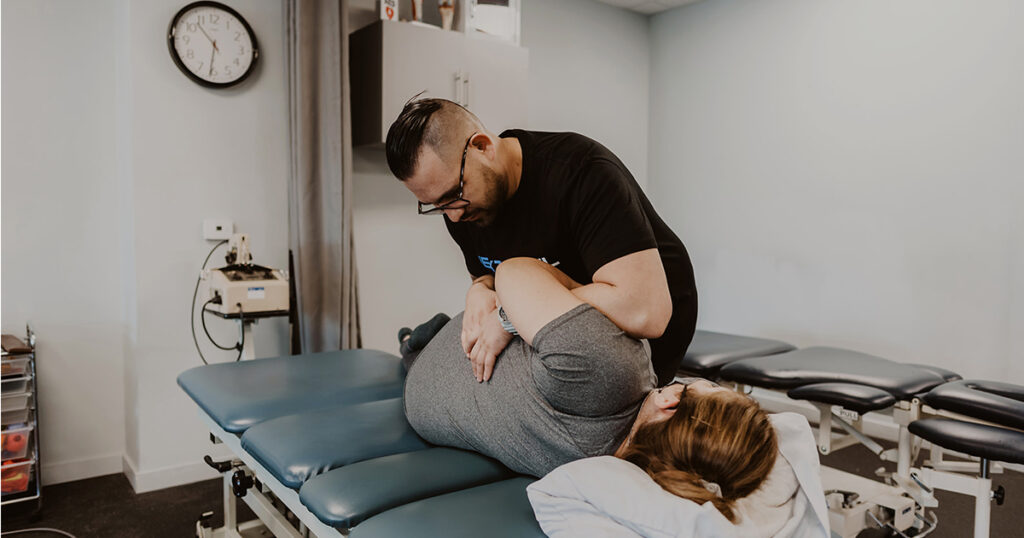Where Are the Sacroiliac Joints?
If you look at the word “sacroiliac“, you’ll see that it describes two areas in the body:
- “Sacro” sounds a little like “sacrum”, which is a triangular-shaped bone in the lower part of the spine, centrally located just below the lumbar spine. The sacrum, unlike most of the spine, is not mobile. It’s made up of five vertebrae that are fused together.
- “Iliac”, the second part of the word, refers to the two large bones (ilium) that make up the pelvis.
The sacroiliac joints are where the sacrum of the spine and the ilium of the pelvis meet. These joints act primarily as shock-absorbing structures. They are held together by a group of strong ligaments, allowing very little motion at these joints.
Dysfunction or injury at the Sacroiliac joint (or SI joint) is one of the most commonly missed causes of low back, hip, groin, and leg pain. Many people have never heard of SI joints and have no idea what their function is within the body. But those who suffer from sacroiliac joint pain are all too familiar with the joints themselves and the pain caused when something goes wrong with them.
What Causes Sacroiliac Joint Dysfunction?
As with most joints in the body, the SI joints are covered by a protective layer of cartilage. When this cartilage is either damaged or worn away, the bones begin to rub against each other, eventually causing degenerative arthritis (sometimes known as “osteoarthritis”) to develop.
Aside from aging, one common cause of SI dysfunction is pregnancy. In fact, pregnancy-related pain in the sacroiliac joints has been estimated to affect almost half of all pregnant women. Hormones released during pregnancy allow the ligaments to relax, allowing for more movement in preparation for childbirth. The increased movement in the joints can and often does cause increased stresses and abnormal wear. In fact, any condition that changes the normal walking pattern puts stress on the SI joints that can lead to pain. This might be one leg that’s longer than the other, or pain in another joint such as the hip, knee or ankle, that causes a change in the way a person walks.
It’s not only too much movement in the SI joints, that can cause problems — too little movement can also lead to pain. The area where a person feels pain depends on whether the problem is caused by too much motion in the SI joints, or too little:
- Too much movement typically causes pain in the lower back or hip area which sometimes radiates in the groin area.
- Too little movement usually results in pain on one side of the lower back or buttocks which sometimes radiates down the leg (similar to the pain of sciatica).
What are the Symptoms of an SI Disorder?
A problem with the SI joints causes symptoms ranging from lower back, hips, buttocks, groin, and legs. The pain is usually worse with prolonged sitting, and transitional movements like rolling in bed, getting in and out of bed, and getting in and out of the car. Sometimes, there may also be stiffness in the SI joints and a burning sensation in the pelvis.
How To Diagnose Sacroiliac Dysfunction
The first step in diagnosing a problem with the SI joints is gathering a medical history and performing a physical exam. Physical exams include range of motion and strength, assessment of pelvic posture and stability, and additional “provocation” tests. Provocation tests are tests where the physical therapist will try to cause your signs and symptoms to pinpoint the cause of your pain and to rule out other possible sources of pain (like the low back and hip issues).
SI Joint Pain Treatment Options
Physical therapy is often very useful in treating SI joint pain. A physical therapist will use modalities like ultrasound, laser, electrical stimulation, cold and heat therapies to reduce pain and inflammation. Your PT will prescribe exercises and stretches that are specific to the cause of your SI joint pain, and often go a long way toward providing significant pain relief.
What’s even more helpful is a specialty field in physical therapy called manual therapy. It's a form of therapy where the physical therapist uses skilled techniques learned through additional training that helps move the pelvis and the spine and optimize the condition of the muscles surrounding the sacroiliac joints.
But it all starts with a thorough and comprehensive physical examination. A good evaluation lays the foundation for successful treatment. At Next Level Physical Therapy, we are passionate about helping you feel your best. Our experienced physical therapists treat each patient with specialized and empathetic care to help ease your pain.
If you have low back pain and want to learn more CLICK HERE TO SCHEDULE.
You can also check out our other articles:
We also welcome you to check out our "Freedom from Low Back Pain and Sciatica Workshop", Saturday, July 17th from 10:00 am - 11:30 am. Register online or call our office to reserve your spot!





